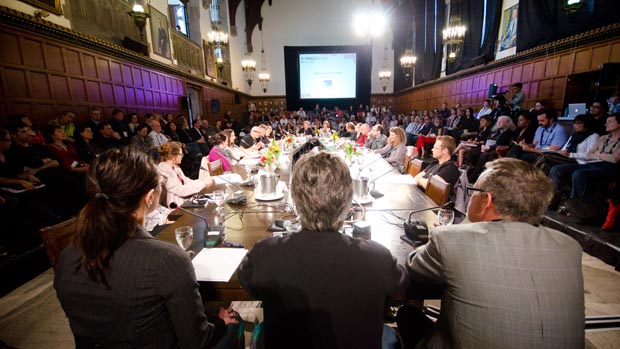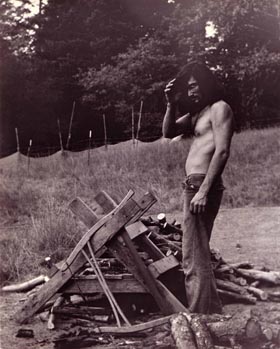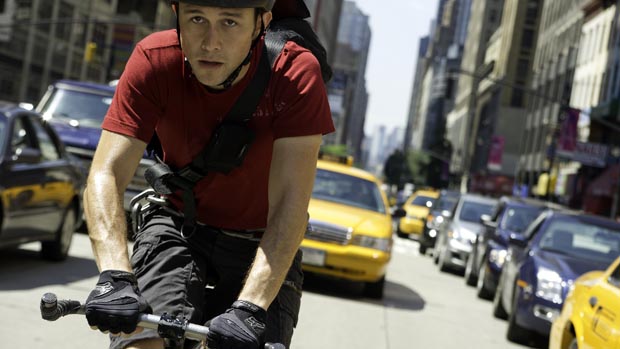 Back to selection
Back to selection
Mood Reels and Lookbooks: In Today’s Pitches, the Image Comes First

The pitch — boiled down to its simplest terms, it’s when someone with an idea tries to sell it to someone with the money or resources to get it made. Writers and directors can pitch their own original ideas or pitch their creative skills to win a job on an already-developed for-hire project. For decades, these pitches were purely verbal. They were about “being good in the room.” But today the pitch game is changing, and it’s a harder game to play than ever before. A great verbal presentation is still key, but filmmakers are increasingly supplementing their pitches with new tools: mood reels, mood boards, trailers, mini-movies, concept boards and scores, even before they walk into that initial development meeting. And this trend is not just apparent at the studio level. In the independent world, with the rise of crowdfunding platforms like Kickstarter and Indiegogo, video presentations have become essential. Where you would once have handed an investor a screenplay, you now direct them to your Kickstarter page that shows not only a video, but also the growing fan base of your film.
The ability to suggest the feel and sensibility of a film through moving images, before that film is made — these are skills and tactics filmmakers need to excel at today. “Most of the studios are expecting visual presentations from directors on meetings for the open directing projects the studio is developing so the studio can now get a feel about a director’s vision for their project,” comments the Gersh Agency’s Scott Yoselowin an email. “And now a director, with the help of a savvy computer graphic artist or storyboard artists, can help create these extravagant visual presentations.” This is becoming as true for established directors as it is for newcomers. Indeed, sighs another Hollywood agent, “Even people with every advantage in the book are going to whatever lengths necessary. It’s just gotten way harder.”
New trends in financing are making mood reels, which can be streamed to far-flung financiers, more important on independently financed projects too. Says manager Gary Pearl of Pearl Pictures via email, “Over the past three or four years, formerly studio-driven films (the nonfranchise type) have increasingly become independent-driven productions. As a result, look books and mood reels have become important additions to the overall package sent to talent representatives, financiers and sales agents, whose job it is to assess a film’s viability in the development and casting stages and advise their various clients or buyers of the ultimate quality of the finished film. These advisors’ support and how they represent a project (to actors, buyers, sales agents, financiers) can mean the difference between a movie getting made or not.”
Perhaps the biggest shocker here, though, is not that the concept of the pitch has evolved, but that it’s taken so long to do so. “It seems really bizarre to me that here we are in 2012, after 100 years of cinema, and the notion of the script as a physical object has hardly changed at all,” says London-based producer Keith Griffiths of Illuminations Films. “I find the script quite obstructive because I can’t get through it into the visual imagination of the director.”
What is a mood reel? It’s important not to think of it as a trailer, but as video that gives a representation of what the film will feel like. “[Through a mood reel,] I’ll get a real sense of the dynamic of the director and the direction the film is going,” says Griffiths. “The goal of the mood reel is to bring the viewer into the atmosphere of your film. You’ve got to capture the imagination of those people who might finance it. You could go through 10 drafts of the script and not achieve that.” Griffiths worked with director Peter Strickland to develop a mood reel for Berberian Sound Studio at the request of Film4. “This was entirely helpful for us in communicating the atmosphere, irony and unique horror elements for a film that was basically a bunch of people in a sound studio talking.”
A mood reel is usually no more than a few minutes in length. Many reels are simply a director’s edit of existing film clips. They could reference lighting from one film with a character’s costume and makeup from another film. They might reveal shooting style or the type of music the film will use.
A mood reel is not overly representative — in fact, quite the opposite. Using only footage from classic gangster films for a mob film will only show that the project doesn’t have anything new to say about the gangster genre. Director Ryan Koo created a mood reel for his Kickstarter page for his indie basketball film, Man-child, and raised more than $125,000. He uses an upbeat Clams Casino track over sports imagery mixed with strong character footage from independent films like Chop Shop, Raising Victor Vargas and Ballast. “I used a few basketball clips, but people already know there’s going to be basketball on screen,” says Koo. “So most of my choices were aesthetic — color palette, location and character-based instead of relying on similar subject matter. I think using clips from movies about a similar subject can give your mood reel too much of a ‘me-too’ flavor.” Koo used voiceover to walk viewers through the images and made a version without voiceover for meetings where he would be present to speak over the reel.
Mike Cahill successfully pitched his breakthrough film, Another Earth, to its producers using a mood reel, but his consists of entirely original footage. He’s employing the same technique now when presenting his follow-up. “I don’t like sizzle reels that use clips from other movies,” writes Cahill via email. “Any new film should have the goal of tapping into our sense of wonder. And recycling old materials sometimes feels cheap and done. Generate your own. Or if you are going to go that route at least employ new and unseen juxtapositions of clips to create something that feels original.”
Cahill spent several months gathering material for his Another Earth presentation, including 10 days shooting original material and then three days on editing and visual effects. He explains, “I spent a lot of time shooting and making composites of the other Earth in the sky in handheld véríté shots to see what that would feel like. I watched, filmed and photographed the moon to see the different placements and feelings it created so I could extrapolate when putting an Earth in the sky. I shot different scenes with Brit [Marling] in the environment of New Haven, the school, the seaside town, the old factories, so I could experience the place and establish a tone for the film, which I call poetic realism — documentary véríté combined with visual compositions and colors that evoke the protagonist’s story arc. I made a dozen posters. I cut together scenes I shot with music. Doing all that is my natural preparation process, and it doesn’t really cost any money.”
In many ways, the mood reel is just an extension of a pitching aid that’s been around for decades: the mood board, or in extended form, the mood, or look, book. Such books can include original photos, magazine and newspaper clippings, and archival photos evoking colors, settings and characters — anything that sets the mood of the story. While this is the type of work typically created by an art department to guide their crews once a project is green lit, directors have often created them themselves while pitching projects.
The mood board is a direct inheritance from the advertising industry, where most commercial pitches draw on commercial images and characters to help brands envision the pitch coming to life. Directors who come from the advertising world often have an advantage here. They have to think up new ideas daily and package them to sell to a client who is prepared to spend a fortune on a 30-second spot. It’s not hard to see how the experience of selling a product to millions of people can translate into convincing a producer how a film is going to connect with its target audience.
David Koepp made a mood book for his upcoming Premium Rush — a bike messenger thriller starring Joseph Gordon-Levitt and Michael Shannon — that reveals a side of New York that most people don’t see on a daily basis. “The book was one of the reasons we greenlit the movie. It just set a tone and palette for the movie that was beautiful,” said Elizabeth Cantillon, executive vice president of production at Columbia Pictures. Koepp’s picture book showed a tour of New York from Columbia University to Chinatown, with stills of garbage strikes and fast-moving bike riders.
Director/producer Katie Jacobs brought in a mood book for the feature Girls Like Us, based on the careers of Sheila Weller’s book about Joni Mitchell, Carly Simon and Carole King, now in development at Sony. “It was a beautiful book,” says Cantillon. “For a period piece, it shows what people looked like then, what California looked like then. It gives you a prism to see into the movie. It just added one more dimension for studio execs that I think really helps.”
For many directors it makes sense to do both a mood video and a mood book. When Christopher Neil first optioned Mark Poirier’s book Goats, he had no idea it would take nine years to see the film come to life. (The film, starring David Duchovny and Vera Farmiga, premiered at Sundance 2012.) Neil, who is a longtime acting coach, went on location to shoot the Tucson desert and East Coast boarding school locales for the film. “It was really beautiful,” says Riva Marker of Red Crown Productions, whose company ultimately developed and produced the film. “It was artistic, cool and really moved us. It also showed us his level of commitment and passion to the project.” Neil also made a three-minute mood reel, a combination of stills and motion footage from films like Gus Van Sant’s Elephant and nature documentaries that inspired him, all cut to a Bon Iver song.
For Neil, the materials had a double effect in helping him get the film made: “One of the ways I could stay inspired about the project while waiting for all the elements to line up was going back to that material.” And once the project was ready to film, he was well ahead of the game in expressing the look and feel to his crew. Today, a focused visual package can help keep the film’s momentum going throughout the entire process.
For those unable to spend a lot of money and time on their mood reels, there’s another tactic: the personal approach. Duane Hopkins explored the U.K.’s new working class with a pitch for his upcoming film, Bypass. He found an environment where youth are pitted against each other, robbing their own friends. It made him question whether morality today is a luxury one has to literally be able to afford. In order to convey these tough themes, Hopkins created a webcam-style video, speaking directly into the camera. He described in a concise and raw manner how his hands-on approach to casting and locations scouting led him to discover a main character whose story needed to be told.
The project’s producer, Samm Haillay, first presented Hopkins’ video pitch to the Torino Film Lab in the filmmaker’s absence. Griffiths saw it there and was blown away, comparing it to “a very intense psychotherapy session.” The buzz in the room translated into concrete backing. “The video pitch has been instrumental in bringing finance to the table. Indeed people have said to me that they didn’t need to take a meeting with Duane after watching the pitch as it did it all for them,” says Haillay. The video — along with a mood book and marketing ideas — then became a tool throughout the development of the film, consistently reinforcing the director’s pure passion for and dedication to his story.
Mood reels alone can’t convince someone to make a film. “Ultimately, a successful feature film track record trumps everything,” admits Yoselow. Still, they are now an accepted and usually required part of the process. When evaluating projects, says Cantillon, “It comes down to the story and my confidence in the person who’s going to execute it.” These new tools aren’t here to replace the human element, but they are another way for directors to do what they need to do — sell their visions, by any means necessary.
The Documentary Pitch
Some of the most creative pitches today, the ones taking full advantage of interactive tools, are found on the documentary film circuit. “The viewing habits of the audience have changed and the marketplace has not yet caught up. So it’s the responsibility of the filmmaker to catch up because no one is going to do that for them,” says Elizabeth Radshaw, director of Canada’s Hot Docs Forum and Market. Today’s filmmaker needs to not only master all the right tools, but also to have an open dialogue with their audience through platforms like Kickstarter and Facebook. It’s up to the filmmaker to wield the entrepreneurial axe.
One project that swept the floor at the Hot Docs Forum has gained wings from its heavy online marketing. Now in postproduction, The Jungle Prescription is a film that tells the story of two physicians, one in the Peruvian jungle and one in Canada, who are using ayahuasca to treat hardcore drug addicts. Throughout the filmmaking process, the directors kept trying to answer the same question over and over: “What is taking ayahuasca like?” To answer it, they’re developing an interactive project alongside the feature.
This interactive project turns the tables by focusing on the audience. It uses HTML5 user-generated content, personality profiling techniques and social media to develop a hypervideo experience that mimics the introspective insights many people discover when taking ayahuasca.
“It is a difficult question to answer because, more than anything, ayahuasca is like a mirror that lets us see parts of ourselves we can´t normally see,” says director Jeronimo M.M. “It is a very personal soul plunging, an exorcism of one’s internal demons. So what people are really asking is, ‘What would it be like for me?’ A film cannot answer that question, for the answer is different for every person. The only way to do it is through interactivity.”
In addition to pitching the film’s trailer, the team is pitching a trailer for the interactive project. They’ve been using their Web presence, Facebook following and two successful crowdfunding campaigns to continually pitch to their audience. While an interactive element can mean a costly addition to an already bursting budget, when helming projects that delve into unchartered territories, it may be just the thing needed to stand out from the crowd.
Tips for making visual presentations and pitches:
Don’t skimp on quality.
You don’t need to spend a big budget on a mood board or mood reel. Sometimes just speaking to the camera will get your story across. But however you choose to shoot it, make it a polished product. Lazy edits, poor styling choices or weak music will all reflect badly on the viewer’s confidence in the director.
Send a concise digital package.
Skip cumbersome physical packages. Everything can be sent in one email, with a digital package giving links to a mood book, reel, concept art, previous work. Once someone has requested to see your package, make it as easy as possible open it up and click on the links.
Have fun with your submission.
“There’s so much creativity demanded of you over the course of the entire project,” says David Hinojosa, head of development at Killer Films. “You have to see it right out of the gate.” Hinojosa points to one of Killer’s projects, a script adaptation by Ariel Schrag of her graphic novel Potential. The cover page of her script is a comic that sets the tone for the entire film. Hinojosa has also received scripts accompanied by playlists to be played during reading.
But don’t be gimmicky.
Be careful not to add something to your presentation just for the “wow” factor. Overall, if an element doesn’t help bring your story to life, skip it.
Keep it short.
Development execs are notoriously short on time. Generally don’t go over three minutes for a mood reel. Edit your photos wisely and show only boards that are needed to visualize the film. You need to have your 30-second elevator pitch, and you should also be able to talk someone through the entire film in less than 15 minutes.
Own your project.
Once you’re in the room, show your enthusiasm. Make eye contact. “Some of the best pitches to come out of Torino were by actors-turned-directors,” notes Valeria Richter of the Torino Film Lab. “They have a natural talent for walking around with a microphone, capturing the audience’s attention and making them laugh.”
Court brutal feedback.
Test your mood reels and presentations on friends and colleagues before sending them out into the wild. And if you aren’t getting enthusiastic responses, don’t be afraid to blow them up and start all over again.
Make your project feel inevitable.
“I learned that as an independent filmmaker, you must treat the making of your film as an inevitability, and you must allow yourself to be impatient with anyone or anything that stands in your way,” says Goats writer/director Christopher Neil. The purpose of creating supporting materials is to create a sense that your film is already happening. Whether through a website, Kickstarter page, blog or marketing package, make it feel like all the elements are all in place. It will make it that much easier for someone to say yes.
Don’t overpromise.
It’s important not to overpromise anything from the reel. There’s nothing worse than an investor backing out because early film dailies don’t match the ambition of the footage shown on the mood reel. The level of films chosen should reflect the intended budget of the film pitched.
Make it for yourself too.
Another Earth’s Mike Cahill reminds that directors shouldn’t just think of mood reels as commercials for their films. “Visual materials that help articulate your vision as a director are certainly useful,” he says. “But for me it is important to view those materials not as part of a sales pitch but rather as a hands-on personal creative exploration, or an emotional archaeological dig into textures, tones, creative choices, technical possibilities, that help you as a director locate the heartbeat of the project. If you look at it that way, the approach becomes freer and more meaningful. And of course, in that exploration, materials are generated — lots of materials.”



